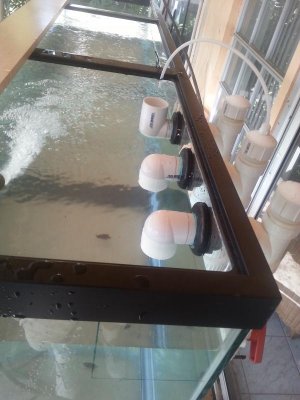It is simple actually LOL... Measure down from the lip inside the trim, 3.25" mark the spot, and pop the hole. It sounds more complicated than it is. Water fall will be ~ 1" or so, up to around 1.5" depending on how far you have to go down past the minimum to clear the trim. Water level in the overflow will be in the top half of the down turned elbows, but can vary a little bit, depending on adjustment.
The water needs to rise on startup so it flows in the dry emergency, that is the upturned elbow. That is sufficient to provide enough pressure to start the siphon fully (assuming the bottom end is right.) Some place the bulkheads elbows too high, and getting the head height is risky in terms of overflowing the tank, some place them way too low, and getting the water level up to where the waterfall is not a noisy mess, is next to impossible without breaking the rest of the design.
The top of the weir should be even with the trim on the outside of the tank... hides the water line by ~ 1/4" give or take, depending on the length of the weir, and the flow rate...
The depth (top to bottom) is based on where the bottom of the elbows end up after all of the above is done. 3/4" below that...Start with the top and work down. That is what I am getting at with 'don't plan for smallest possible dimensions you will get in trouble.' It will be however high it needs to be.
It is based on the given dimension below the lip inside the trim. If you measure down that far, mock up the bulkhead, see if it clears the trim, if it does, golden, if not, drop it down until it does. The tank will talk to you, as I said, it is not horribly complicated...
Bush off the pump directly to 1". Don't pass go, do not collect two hundred dollars on the way...

Friction loss can vary with the number of fittings, types of fittings, and length of pipes between, it can be very significant. In 3/4" pipe/hose the friction loss is most often excessive.





